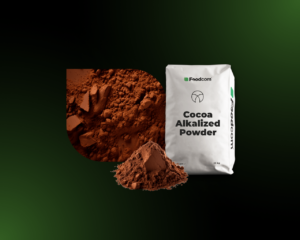- Foodcom S.A. expanded its FMCG sector with new products and entered the European and Chinese markets.
- Vegetable proteins, especially soya, gained popularity as cost-effective alternatives, while cocoa prices increased due to market volatility.
- Conflicts and attacks by the Yemeni Huti on ships in the Red Sea and Horn of Africa region require international diplomatic efforts.
The first half of 2024 brought many dynamic changes to the market. Below you will find the most important events and trends from this period.
FMCG
The FMCG division at Foodcom S.A. is growing at a dizzying pace! We have enriched our range with products such as Brita Pro, La Roche-Posay and the legendary Monster Energy Drinks. This year we have boldly entered markets in the UK, Slovakia, Germany, Spain, Romania, France and Denmark as well as China. We lead the way by offering the highest quality and guaranteeing reliability. Discover our new products and join our growing community of satisfied customers!
PLANT-BASED
Plant-based proteins such as peas, rice, potato and especially soya have gained huge popularity over the past six months. They offer a healthier and cheaper alternative to traditional protein sources.
In addition, the cocoa market has been characterised by high volatility in recent months. For another year in a row, a poor harvest is forecast, leading to a significant increase in the price of this raw material due to reduced availability. The search for alternatives, such as locust beans, is currently underway.
ADDITIVES
Raw material markets are experiencing turbulent times, with changing consumer preferences, geopolitical tensions and logistical challenges shaping new trends. Rising freight prices have a direct impact on the cost of raw materials imported from China and are destabilising global additive prices.
European logistics, Brazilian renewables and Indonesian agriculture are transforming their sectors in response to these dynamic changes. Is the world preparing for a commodity revolution?
DAIRY
The first half of 2024 was characterised by volatility and unpredictability in the dairy market. After an initial stagnation, the market gained momentum, leading to sharp price increases, especially for fat products such as butter, AMF and FCMP, as well as whey and milk concentrates. These prices have now stabilised, which is typical for this time of year, with high demand and limited volumes keeping producers in a favourable market position.
A particularly important development in the first half of the year was the decline of China as an export market for the EU. The EU dairy industry must therefore prepare for the economic challenges ahead, which may bring more difficult conditions in the second half of the year.
NEWS
Bird flu attacks the agricultural sector in the US
The US has seen major problems in the agricultural sector due to avian influenza, which has infected 80 dairy herds, causing significant economic and logistical disruption. Goats and cats that consumed unpasteurised milk were also infected, as well as three people in direct contact with sick animals. Mild symptoms such as conjunctivitis and coughing were observed in humans.
Research by the National Institute of Allergy and Infectious Diseases indicates that the H5N1 virus is capable of surviving the milk pasteurisation process. Despite this, experts still consider milk to be a safe product for consumption.
The bird flu epidemic, which began in 2022, has affected more than 90 million chickens and 900 wild birds. This year, the virus has spread to other livestock in nine states, leading to higher milk prices and further supply disruptions.
Authorities and research institutions continue to monitor the situation and work on strategies to prevent further spread of the virus.
Record cocoa prices due to drought and diseasec
The first half of 2024 was difficult for the global cocoa market, especially in West Africa, accounting for 80% of global supply. The region struggled with droughts caused by the Harmattan phenomenon and excessive rainfall associated with the La Niña cycle. In Ghana, yields fell to 580,000 tonnes and plantations were hit by outbreaks of swollen shoot virus and black pod disease.
Crisis in the Horn of Africa: attacks and wars destabilise the region
In the first half of 2024, the crisis in the Red Sea and the Horn of Africa reached a new level. The Houthis of Yemen have carried out attacks on ships in support of Hamas in its conflict with Israel, reminiscent of the Somali piracy problem of a decade ago. US and allied military interventions are aimed at quelling the threat.
Political violence and state fragmentation in the Horn of Africa, particularly in Sudan and Ethiopia, are contributing to the destabilisation of the region. The civil war in Sudan has created the world’s largest refugee crisis, with millions of people forced to flee their homes. In Ethiopia, internal conflicts are worsening relations with Eritrea, which could destabilise the entire region.
American diplomatic support is crucial to prevent further escalation of conflicts. The growing influence of countries such as Russia and Iran in the region further complicates the situation. Stabilising the Red Sea and the Horn of Africa requires a broad diplomatic coalition, with the US at the forefront.








